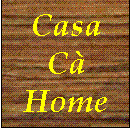


Piedmontese Grammar
We had already a look at the Prepositions (and we still recall something about), then we have to speak about Conjunctions, Adverbs, Exclamations. This will conclude this short "fly" over the Piedmontese language.
Also in Piedmontese, as it is in Italian, the adverbs are classified into manner (manera), quantity (quantità), time (temp), place (leu), opinion (opinion). In Piedmontese there are many adverbial locutions, which are very used. We also remember that adverbs have forms of comparative and superlative, to which what said about adjectives can apply. We will speak about this point.
We note that, also in Piedmontese, there are words that can be used as adverbs, or as adjectives, pronouns, and so on, depending on the particular context in which are used.
completely = ëd pianta
abundantly = a malòch
luckily = për asar
accidentally, randomly = a l'asar
quickly = zichin zichet
unwillingly = dë stracheur
on one's shoulders, on = a còl
seldom = da ràir
blindly, rashly = a catòrba
rudely = dë sfrandon
secretely = dë scondion
truly, really = për dabon
on purpose = a spréss
accuralely = për da bin
unfortunately = belavans
and so on (some pages in the vocabularies)
Then there are a number of manner's adverbs coming from the descriptive adjectives , and there is a rule for deriving them, that is: take the feminine singular of the adjective and add the desinence ment. This is not an absolute rule, and not always it works. For example the adjective quiet is translated into tranquil, the feminine singular is tranquila and by adding ment we obtain tranquilament = quietly. This rule is similar to the english one, where the suffix added to the adjective is "ly". Anyway, these adverbs are mainly to be considered as italianisms, even if they are quite used. In true classical Piedmontese there are also words that can be either descriptive adjectives or manner adverbs without changing. For example the word ancreus means deep (adj.) but also deeply (adv.). Of course, as adjectives they can change in gender and number, but as adverbs they are invariant. Then there are other words that can be substantive or manner adverbs, and so on. Otherwise there are specific words for the adverb or locutions, that are very common, making use of "an manera + adjective feminine singular (it is referred to "manera")" or "da + adjective (that can be in agreement in the context). Examples:
fòrt = strong , strongly
bin = well ; méj = better
mal = badly ; pés = worse
adasi = slowly ; dun-a = quickly
an manera stupida= stupidly ; da fòl = foolishy
volonté = willingly
parèj = so, in that way
apòsta = deliberately
ampressa = quickly, fast, rapidly
Then there is a series of piedmontese adverbs very close to the correspondent french adverbs (they are written, anyway, with a different graphy) and that come from beyond Alps. Among these adverbs there are:
dosman = sweetly, kindly
maloreusman = unluckily
notaman = mainly, particularly
vreman = truly, really
vitman = quickly
etc.
About "vitman" we have to note that in French there is not a similar corresponding adverb. This is an analogy having a piedmontese origin.
Examples of comparative and superlative with adverbs
Rules for comparetive and superlative with adverbs are the same of the ones related to adjectives. So we don't repeat all the description of these rules since we think that the question will be completely clear just after some examples. We still note that in Piedmontese "pì/manch ... che ..." (literally: "more/less ... that...") is preferred with respect "pì/manch ... ëd ..." (literally: "more/less ... of ...").
I go more quickly than you = I vado pì ampressa che ti
I go very quickly = I vado motobin ampressa
I went more far away than you = I son andàit pì lontan che ti
I went less far away than you = I son andàit manch lontan che ti
He comes very seldom = A ven motobin da ràir
You will go quickly as much as possible (the most you will be able) = It andras ël pì vitman che it podras
More than in this way... = Pì che parèj ...
As a last note we recall that in Piedmontese (but not only) there are sorts of alterations for adverb, usually as the diminutive for nouns a classica example is: "adasiòt = slowly, but an underlined "slowly" (the meaning of these forms is idiomatic, and can be achieved only with practice).
much, very = tant
so much = motobin, vàire
enough = assè, pro, basta, bastansa
too much = tròp ;
less = meno, manch
only = mach
few = pòch
more = pì
nothing = gnente, nèn
Then there are some locutions like:
... and even more = ...e passa
just a bit = tansipòch
Then ve note that the adverb "vàire" = "so much", when used in questions, assumes the meaning of "how much?".
We can note that there aer some of these adverbs that are equal to corresponding adjectives (this is true also for English and Italian). In Syntax we will underline some particular behaviour of adverbs and adjectives of this type, in particular we will see "motobin" and "pòch" that show some particularities.
at once = sùbit, ëd longh
often = sovens, minca pòch
now = adéss
after = dòp. apréss
then = peui
never = mai
always = sempe, semper
today = ancheuj
yesterday = jér
the day before yesterday = l'auterdì
tomorrow = doman
etc.
Nothing else relevant about them (see vocabulaty).
Then we give a list of these adverbs:
here = sì, ambelessì
there = lì, là, ambelelì, ambelelà
near = davzin
far = lontan
in front = anans, danans
after = daré, darera
inside = drinta
outside = fòra
over = d'zora
under = sota
where = andova, anté
etc.
As usual,. the complete list can be found in the vocabulary.
Affirmative:
yes = sì, é, é-é, oj, euj
certainly = sicura, pròpi, bò
really = dabon
really, exactly = franch
yes, certainly = già
yes, good = bin
surely = sens'àutr, pà privo
exactly, just = giusta
etc.
Negative:
not, no = nen, nò, pà
absolutely not = nen d'autut
no more = pà pì, pì nen
never again, never more = pà pì, mai pì
etc.
Dubitative:
maybe = fòrse, maraman
could be = miraco
who knows, I wonder whether = chissà (se)...
accorrding to ... , it sepends on ... = conforma
by chance = salacad
probably = probàbil
etc.
We note here the following ways of saying of the Piedmontese:
yes, yes sir = sì-sgnor(also in jocular sense)
no, no sir = nò-sgnor(also in jocular sense)
to say yes = dì che 'd sì
to say no = dì che 'd nò
I think yes = miraco sì
I think not = miraco nò
We will see again these expressions later.
Prepositions are used to specify complements. We remember that in Piedmontese not all the complements use the same prepositions that are used in English or in Italian. On this point we say something more in Syntax. We already mentioned some piedmontese particularities in using prepositions (see Articles, prepositions and prepositions linked with article). We recall the main points:
dë = of (different forms, can be linked with article)
a = to, at (can be linked with article)
da = from, by (can be linked with article)
an = in, into if it is followed by an article becomes ant (never linked with article)
con = with (never linked with article)
su = on, over (can be linked with article) when this preposition is linked with article usually is preceded by the preposition an
për = for (never linked with article)
fra = among, between (never linked with article)
also all the other prepositions are never linked with article.
We repeat here, for completeness, what we said about preposition at the beginning of this grammar.
Later, while speaking about syntax, we will better see what complements are associated to the various prepositions. In some cases piedmontese complements make use of prepositions that are different from the ones used in Italian, in French and in English, Here we recall what is the piedmontese translation of the most common english prepositions, used for making complements:
in, inside, into are translated into: an, ën
to, at, into are translated into: a
among, between are both translated into: tra, fra (the first is less used).
on, upon, up, above are all translated into: su, dzora (d'sora)
under, below are translated into: sota
of, from, with, for are respectively translated into: dë (ëd), da, con, për
We note that the two english prepositions from, by are both translated into the piedmontese preposition da.
Other prepositions can be found in the vocabulary. In piedmontese sometimes more than one preposition can be connected to form a prepositive locution, often having an idiomatic character. In the following we report some prepositions and prepositive locutions.
piedm.: drinta, engl.: in, inside.
piedm.: fòra, engl.: out, outside.
piedm.: danans, anans, dnans, engl.: in front.
piedm.: darera, engl.: behind.
piedm.: dòp, engl.: after.
piedm.: vers, engl.: toward.
piedm.: dë'd sà, engl.: on this side.
piedm.: dë'd là, engl.: beyond.
piedm.: da's për tut, engl.: everywhere.
Some particular usage of prepositions, as already mentioned, is described in Syntax. Other piedmontese prepositions are in the Vocabulary.

